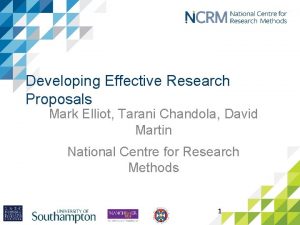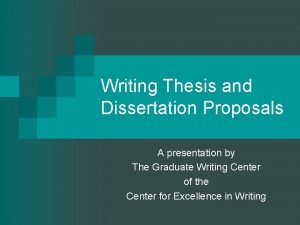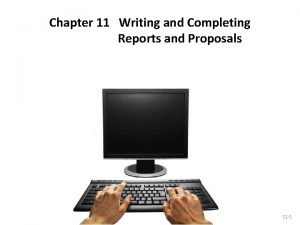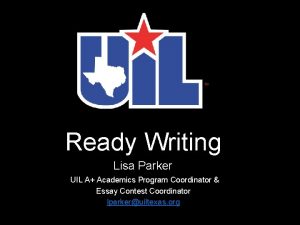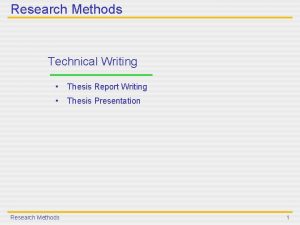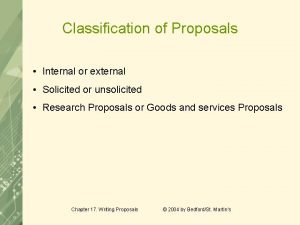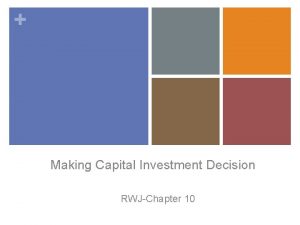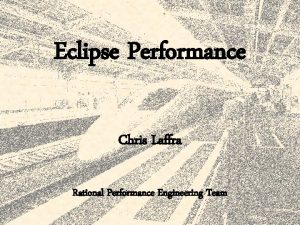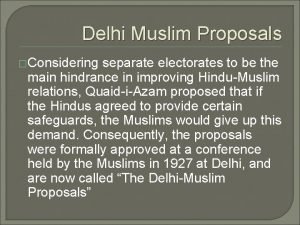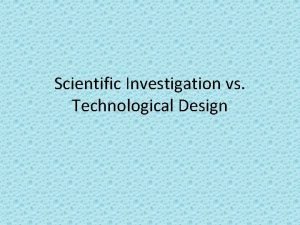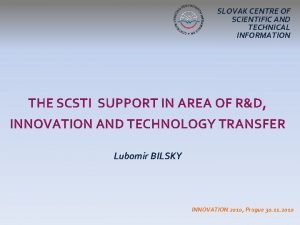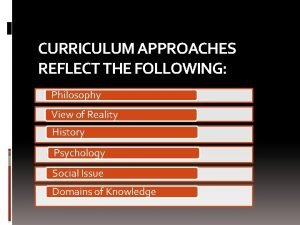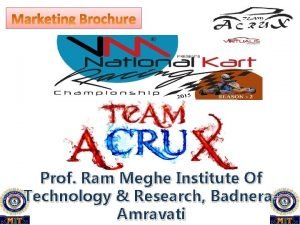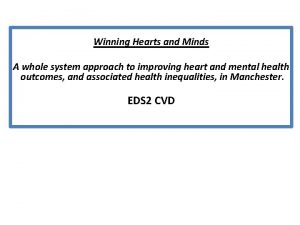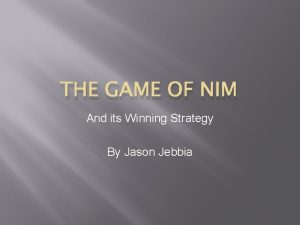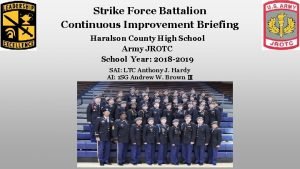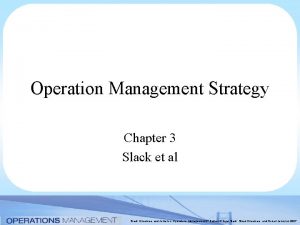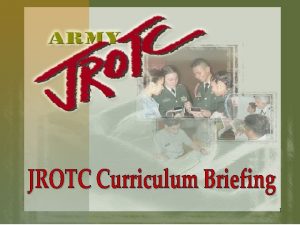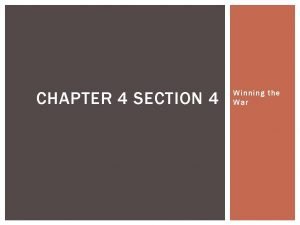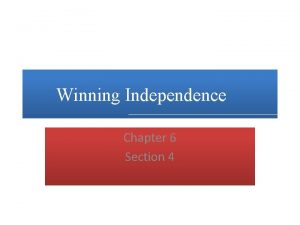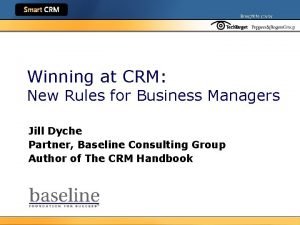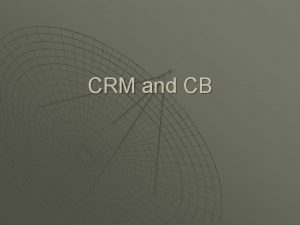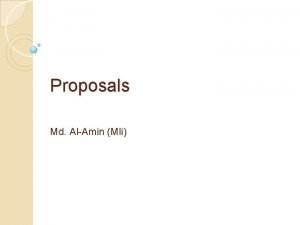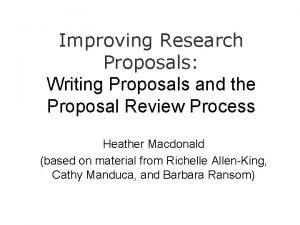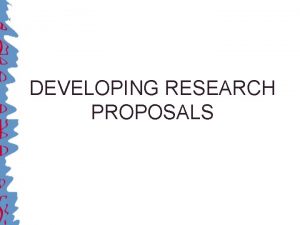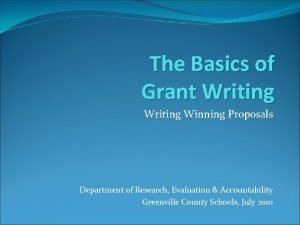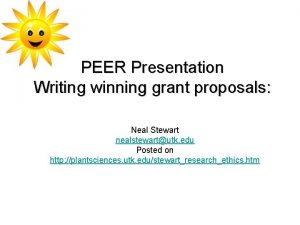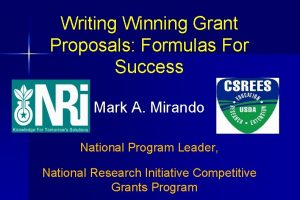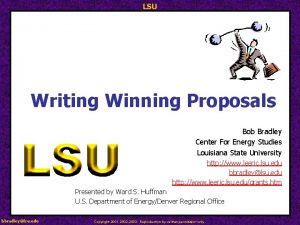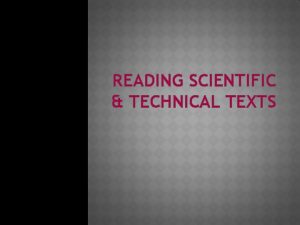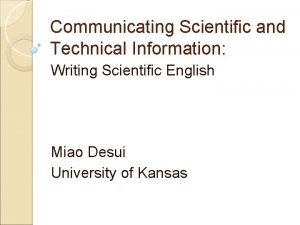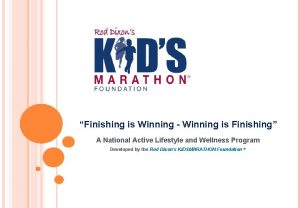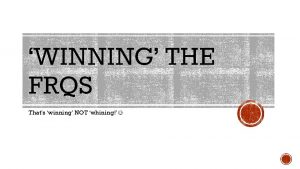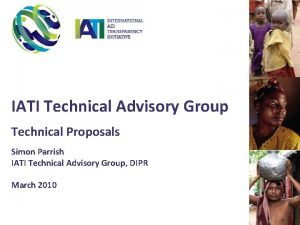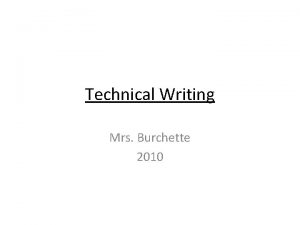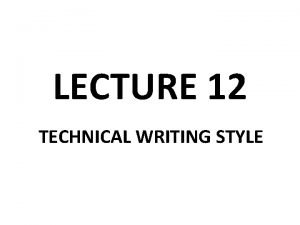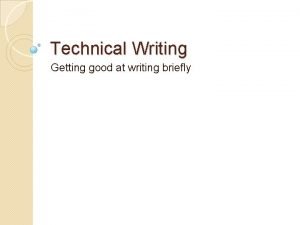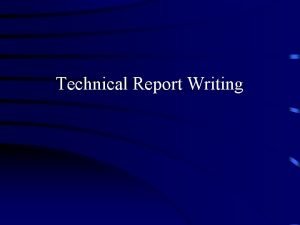SCIENTIFIC TECHNICAL WRITING WINNING RESEARCH PROPOSALS Prof R



































- Slides: 35

SCIENTIFIC & TECHNICAL WRITING WINNING RESEARCH PROPOSALS Prof. R. L. BOXMAN Tel Aviv University Communicating Science: 5 6 Nov 2013 - USYD Winning Research Proposals R. L. Boxman, 9/2000 1

OBJECTIVE OF THE RESEARCH PROPOSAL • Convince someone to allocate you resources to pursue proposed research project • $$ grant (granting agency – government, public, company) • Use of facilities, personnel, time (including your own) (internal) 6 Nov 2013 - USYD Winning Research Proposals 2

WHAT DOES THE ‘GRANTER’ WANT TO KNOW IN ORDER TO MAKE A DECISION? • Is the subject worthy of study? – According to the granter’s criteria: significance – • Scientific advancement • Applications • Adherence to particular subject area Winning Research Proposals 3

WHAT DOES THE ‘GRANTER’ WANT TO KNOW? What is the probability of success? • • Methodology/work program Qualified team Familiarity with the subject Adequate resources? – equipment – personnel 6 Nov 2013 - USYD Winning Research Proposals 4

WHAT DOES THE ‘GRANTER’ WANT TO KNOW? Resources required (bang/buck) • Budget • Time Often intense competition between proposals for available resources. 6 Nov 2013 - USYD Winning Research Proposals 5

STRUCTURE OF THE PROPOSAL Usually dictated by the granting agency – standard forms. • Structure given here typical, -can serve as a model if no structure is specified. • 6 Nov 2013 - USYD Winning Research Proposals 6

PROPOSAL STRUCTURE 1. Abstract 2. Subject area 3. (Scientific/Technological) Background 4. Objectives 5. Expected Results and Significance 6. Methodology 7. Work Plan 8. Resources 9. References 10. Budget 11. CV’s of key personnel 12. Letters of cooperation 6 Nov 2013 - USYD Winning Research Proposals 7

1. Abstract • Typically ½-1 page • Summarize: – – – 6 Nov 2013 - USYD Subject area, Objectives, Methodology, Expected results and their significance, Resources required Winning Research Proposals 8

Abstract • 3 rd person • Most sentences passive • Write (or at least re-write) after remainder of the proposal 6 Nov 2013 - USYD Winning Research Proposals 9

2. Subject Area • Short (¼-½ page) description/definition of the subject area • Intended to help administrators decide on which committee/staff/reviewers should handle the proposal • Should be general enough that a nonspecialist can understand • Some similarity to Stage I of the research report introduction 6 Nov 2013 - USYD Winning Research Proposals 10

Subject Area Example • Proposal on Cyclotron Resonance Masers Cyclotron resonance masers (CRM’s) are devices for generating microwave radiation based on the interaction of an electron beam with static magnetic field and a resonant cavity. Microwave sources are used for household microwave ovens, radar systems, and backbone communications links. In the cyclotron maser, energy is transferred from the kinetic energy of the electron beam to an electromagnetic wave, when the resonator cavity is tuned to the electron cyclotron resonance frequency, i. e. the frequency in which the electrons rotate around magnetic field lines. In CRM’s with relativistic electrons, the mass of the electron decreases as the electron beam propagates, due to the transfer of its energy to the electromagnetic wave. Thus resonance conditions may be present at one location in the maser, but not at others, if the design parameters are constant along the length of the beam. This phenomena limits maser performance. In the proposed research, a new design concept will be developed in which the magnetic field is tapered along the length of the beam. In this manner resonant conditions will be present at every axial location, and thus higher power can be extracted from the electron beam. 6 Nov 2013 - USYD Winning Research Proposals 11

3. Scientific and/or Technological Background • Similar in structure to Stages I-III of the Introduction of a research report Same rules re. grammar • Typical length 2 -3 pages • Bulk should be in stage II – detailed description of previous work very close to the proposed subject area 6 Nov 2013 - USYD Winning Research Proposals 12

Background continued • Should include under a clearly identified heading, preliminary unpublished results (in my opinion) – Published results from the present group handled above like all other previous work – Sometimes a separate preliminary results section is demanded 6 Nov 2013 - USYD Winning Research Proposals 13

Background continued • Conclude the background section with a short gap paragraph – Summarize what was not done (or done incorrectly), or open questions – Gap sentences are always negative in form: “X was not previously investigated. ” 6 Nov 2013 - USYD Winning Research Proposals 14

Background – gap paragraph – Be definitive, not “wishy-washy” • Do not use: – “to the best of our knowledge…” – “most of the previous research…. ” – “only a few of the previous researches…” • The above raise questions that you do not want the reviewer to ask • Instead, precisely pin-point the gap 6 Nov 2013 - USYD Winning Research Proposals 15

4. Objectives • Corresponds to Stage IV of the research report introduction, but more detailed • Short paragraph in length (2 -4 sentences) § First state overall objectives § Then intermediate and/or more specific objectives • The objective is never “to study” or “to investigate: – instead “to determine”, “to develop”, “to solve”, etc. 6 Nov 2013 - USYD Winning Research Proposals 16

5. Expected Results and Significance Corresponds to Stage V (value statements) of the research report introduction • Very Important! • Answers the question: – o. k. if you succeed in obtaining your objective – so what? ? • 6 Nov 2013 - USYD Winning Research Proposals 17

Significance continued • What will achieving the objective allow you or others to do, that they can’t do now, or how will it improve their ability to do these tasks? – additional scientific questions that can be addressed – new medical/technological/industrial products or processes – etc. 6 Nov 2013 - USYD Winning Research Proposals 18

Significance continued · Be specific – no general b. s. · If you can’t define the expected significance: Ø you probably won’t obtain approval, Ø and you should be asking yourself why you want to choose to do this research! 6 Nov 2013 - USYD Winning Research Proposals 19

6. Methodology • Answers the question: “How will the objective be obtained? ” • Describes experimental, theoretical, and analytical techniques – Brief descriptions for well known techniques (give reference) – Detailed descriptions for new, innovative techniques 6 Nov 2013 - USYD Winning Research Proposals 20

7. Work Plan • Sequence of events to be followed • May include options based on results – i. e. like a flow chart, with decision points. These should be explained • Include a time table or Gantt chart, indicating when the various events described above will occur 6 Nov 2013 - USYD Winning Research Proposals 21

6 -7. Methodology and Work Plan • 6 and 7 frequently are combined in a single section. You should keep the distinction between them clear, and provide both, even if within a single section • 6 and 7 are the heart of the proposal, and should together constitute more than half of the body of the proposal 6 Nov 2013 - USYD Winning Research Proposals 22

6 -7. Methodology and Work Plan • Without a clear methodology and work plan, the proposal will be rejected • Describe what you plan to do • not what you have already done • and not what you might possibly do • Use future tense and passive voice • Ex: “The electron density will be measured using laser interferometry. ” 6 Nov 2013 - USYD Winning Research Proposals 23

Examples • Methodology The microwave power output will be measured with a calibrated diode detector located adjacent to a dummy load in an x-band waveguide attached to the output of the maser. • Work plan The first task of the proposed program will be to formulate model equations for peristaltic transport of the embryo in the human uterus. The equations will be adaptations of those used in Roberts’ model [21] for peristaltic transport in the gullet. 6 Nov 2013 - USYD Winning Research Proposals 24

8. Resources Describe briefly • Proposing organization • Facilities available for proposed research (in your lab, elsewhere) • Key personnel who will participate • brief: – 1 -3 sentences for principal investigators – 1 -2 sentences for others 6 Nov 2013 - USYD Winning Research Proposals 25

NOTE: • Sections 2 -8 constitute the body of the proposal • Typically limited rigorously to 10 pages 6 Nov 2013 - USYD Winning Research Proposals 26

9. References • List cited references. • Use a uniform style. 6 Nov 2013 - USYD Winning Research Proposals 27

10. Budget • Follow guidelines of granting agency – don’t request what they won’t provide! • Use forms provided • If none provided, detail expected expenditures, organized by category: ü Salary and benefits ü Equipment ü Supplies ü Services ü Travel ü Other ü Overhead 6 Nov 2013 - USYD Winning Research Proposals 28

Budget continued • Separate lines for each item within a given category – separate column for each year • Use a spreadsheet to develop your budget • Budget justification – explain large and unusual requests 6 Nov 2013 - USYD Winning Research Proposals 29

11. CV’s of key personnel follow guidelines 12. Letter of cooperation for BSF, GIF and similar multi-institutional projects 6 Nov 2013 - USYD Winning Research Proposals 30

PROPOSAL REVIEW PROCESS • “Invited” proposal – The ‘inviter’ will act as a ‘champion’ for the proposal, provided you give him the ‘ammunition’ he needs to convince whoever controls the purse strings 4 Feb 2016 - INP Winning Research Proposals 31

Response to public call for proposals • Very competitive • Proposal has to be not merely ‘good’, but among the best x% of those submitted • Many referees look for weak points, as an excuse for rejection 6 Nov 2013 - USYD Winning Research Proposals 32

Ph. D. Candidate Exam • Examiners need to determine: – Is the subject and scope worthy of a Ph. D. degree? – Are the methodology, work plan, and timetable realistic and resources adequate, so that there is a good chance that the research will be completed within the allocated time (5 yrs. )? – Is the candidate qualified to conduct the research? 6 Nov 2013 - USYD Winning Research Proposals 33

Most Common Problems • • • Statements in wrong section Lack of a definitive gap paragraph Objective not clearly stated Significance of work not emphasized Inadequate work program 6 Nov 2013 - USYD Winning Research Proposals 34

Summary • • The proposal must convince Summarize key points in the abstract Review literature closest to proposed work Definitive gap sentence Clear Objective Emphasize Significance Detailed work program Methodology + Work Program > 50% of proposal body 6 Nov 2013 - USYD Winning Research Proposals 35
 Technical writing vs academic writing
Technical writing vs academic writing Developing effective research proposals
Developing effective research proposals Title of the study
Title of the study Writing and completing reports and proposals
Writing and completing reports and proposals Prefatory and supplementary part of proposal
Prefatory and supplementary part of proposal Ready writing uil tips
Ready writing uil tips Research methods and technical writing
Research methods and technical writing Difference between formal and informal proposals
Difference between formal and informal proposals Artificial intelligence thesis proposals
Artificial intelligence thesis proposals What is solicited external
What is solicited external Features of fire insurance
Features of fire insurance Capital investment decision
Capital investment decision Eclipse computing proposals slow
Eclipse computing proposals slow Delhi muslim proposals
Delhi muslim proposals Technological design and scientific investigation
Technological design and scientific investigation Slovak centre of scientific and technical information
Slovak centre of scientific and technical information The eclectic model
The eclectic model Personal and cultural expression global context
Personal and cultural expression global context Scientific inquiry vs scientific method
Scientific inquiry vs scientific method How is a scientific law different from a scientific theory?
How is a scientific law different from a scientific theory? Prof ram meghe institute of technology and research
Prof ram meghe institute of technology and research Winning hearts and minds manchester
Winning hearts and minds manchester Winning color red
Winning color red Nim winning strategy
Nim winning strategy Classes of supply army
Classes of supply army Operations strategy slack
Operations strategy slack Core abilities
Core abilities Evangelical church winning all
Evangelical church winning all 603 keno
603 keno Chapter 4 section 4 winning the war
Chapter 4 section 4 winning the war Winning executive summary
Winning executive summary Chapter 6 section 4 winning independence
Chapter 6 section 4 winning independence Crm.winning.cb
Crm.winning.cb Up student plagiarizes prize-winning photos
Up student plagiarizes prize-winning photos You are anurag/anuradha of city public school
You are anurag/anuradha of city public school Crm.winning.cb
Crm.winning.cb

